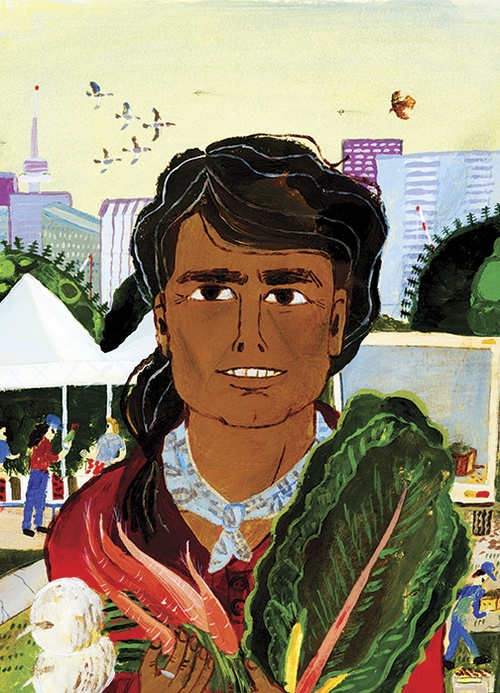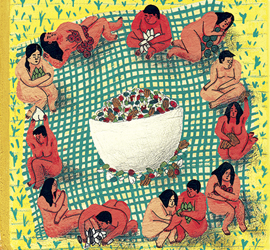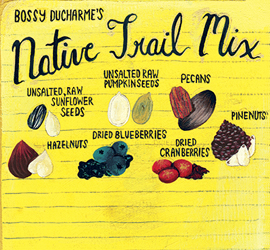 Illustration by Esther Pearl Watson.
Illustration by Esther Pearl Watson.
Memory's Harvest
A growing number of indigenous people in Canada are experimenting with traditional diets, and the trend is about more than just health.
HE IS SHOCKED to find somebody in his bed until he realizes that somebody is him. He lies on his side with his hands clasped underneath his head—the same position he was in when he fell asleep.
He begins to move further away from the prone figure, a dolly-zoom effect, as though his spirit is detaching itself from the body through mitosis. He is floating upwards. It’s just a dream, it’s just a dream, it’s just a dream. His heart begins pounding. Lub-dub. When he reaches the top of his bedroom wall, his hand goes through the other side, followed by his head and the rest of his body. He sees twinkling stars, vast space. Lub-dub, lub-dub. When he turns to look back at his body, he sees the earth from the vantage point of the moon. Did he die? No heaven, no hell and no purgatory; he floats only amidst an endless void. He never got to paint. He never got to fall in love. The statistics that define his people hurtle at him like asteroids. Highest diabetes rate! Highest suicide rate! He never got to help his people.
When Bossy Ducharme, a forty-three-year-old Anishinawbe from Winnipeg, Manitoba, who now lives in Toronto, woke from his vision that night in October 2007, he jumped out of bed, flicked on the bedroom light and fell to the floor, where he cried until sunrise. It was time for change. The Creator, the indigenous version of God, had come to him with a desperate plea to improve his health. At the time, he weighed 223 pounds. Earlier that year, after a routine blood test, Ducharme’s doctor had called him on the phone and spoken “in one of those doctor tones.” Ducharme was diagnosed with hyperlipidemia, an excess of fats in the bloodstream. “If you don’t make any lifestyle changes now, because you smoke, you drink, you’re obese ... ” said the doctor.
“Are you calling me fat?” asked Ducharme.
The indigenous community, stripped of their cultural practices as a result of European colonization, has long experienced a disrupted relationship with food. A domino effect of health problems echoes through generations long-severed from their traditional ways of nourishing. The result is something like a phantom limb syndrome, where the body craves something no longer there. But as indigenous people make increasing moves to urban areas, some are finally beginning to undo the damage.
THREE YEARS AFTER his vision, Ducharme was still unhealthy. “Everything that could stop me from doing this diet happened,” he says. Faced with financial difficulties, job changes and the sudden deaths of those close to him, Ducharme took years to do the necessary research to solve his health problems. Eventually, he decided to try a traditional indigenous diet. Beginning on September 21, 2010, Ducharme consumed only foods that were available to his ancestors before European colonization. His diet lasted just over a year.
Returning to tradition was Ducharme’s way of salvaging his heritage. The staples of his diet were buffalo, deer, salmon, turkey, pickerel, wild rice, berries, greens, homemade smoothies and his “Native Trail Mix.” He sourced ingredients for 5,000 calories a day—a count that initially made his doctor wary—from Toronto’s St. Lawrence Market. “I got a few challenges, especially from the medical community,” Ducharme says. “I got people fighting with me, including my relatives. But I don’t care what people say because I did it for me ... It was the best thing that I’ve done in my life.”

When Ducharme began his diet, there were no trendy cookbooks to guide him. After five days, he had a breakdown. “I was craving salt so much I wanted to lick the curb,” he says. From there, he learned to use natural sweeteners, such as maple syrup, to add some kick to his dishes. That year, he became more “present,” his hair, fingernails and toenails grew thicker, his eyes became whiter, jaw line more prominent, skin clearer. “There was no breakfast, lunch and dinner,” says Ducharme. “I realized that these were concepts that were brought here. My people weren’t gathering in a teepee at noon and having little appetizers.”
Ducharme successfully boosted his health, dropping 80 pounds and inspiring other indigenous people to do the same. He kept a daily blog called Bossy Ducharme Journal Diet that gained him 2,000 new Facebook friends, attention from mainstream news outlets like the National Post and speaking engagements from small Ontario reserves to New Zealand.
His diet may seem familiar; it’s similar to the popular Paleo plan. (Otherwise known as the “caveman diet,” it pushes meat, fish, fruit and vegetables and shuns dairy, refined sugar and grains.) But for indigenous people, refusing post-colonial nutritional influences is about more than health and trend: it is an assertion of sovereignty.
THE BODY HUNG FROM A METAL HOOK in the garage. I wasn’t supposed to go in there, he told me, but my childish curiosity won out every time. This was a fresh kill. Most of the gore had been cleaned up but a few spots of dried blood were scattered across the concrete floor, lingering like the spirits of all the other carcasses that had been sliced out in this dingy space. The coppery smell, which was sometimes so strong my knees buckled, hadn’t asserted itself yet, though a faint taste of metal did assault my mouth. Those fall days promised possibility for my uncle—an opening to the season when animals became prey and food for the winter was stored. For me, it was a time when the dead brought us life.
My uncle never used his garage to park his truck: he used it to flaunt his kill. The dismemberment process I recall from my childhood—the skinning, the chopping—may seem gruesome and unusual to some, but for many traditional indigenous hunters, it means survival. Once he cured his meat (moose, deer, bear, partridge) he would cut portions himself or, in his later years, bring pieces to the local butcher for a more refined job. Large stockpiles were stored in his basement in an industrial freezer and kept as food for the winter: meat pies, roasts, fish fillets. Traditional eating was an act of necessity for my uncle, a way to cut costs and maintain the cultural practices his people were long forbidden from engaging with.
The indigenous peoples' tenuous relationship with food results from a history of attempted assimilation. Prior to European colonization, which began in the late 1400s, indigenous people were agricultural pioneers. The Haudenosaunee, a confederacy of six indigenous nations, grew staple crops including corn, beans and squash (together, called The Three Sisters). Hunters, such as the northern Gwich'in tribe, routed their prey by using stakes and brushes to build fences. They developed plant-based painkillers and implemented tribe-specific strategies for harvesting and hunting season. But the Indian Act, put into place by the Canadian government in 1876, sought to weaken all aspects of indigenous life including food security methods.
Throughout the twentieth century, indigenous children were forced away from their communities into the government-funded residential school system, where the goal was to “to kill the Indian in the child” and assimilate them into dominant white culture. “Often, mealtime would be a place where children would be punished and have their meal withheld,” says Heather Howard, a research affiliate at the University of Toronto’s Centre for Aboriginal Initiatives. “All of those experiences left a mark on the people, as far as a sense of powerlessness around having a good relationship with food.” In the forties and fifties, more than 1,300 indigenous people, mostly children, were used as test subjects to verify the effectiveness of vitamin supplements and were kept on starvation-level diets.
These experiences alienated generations of indigenous people from their traditional practices. “The introduction of commercial foodstuffs has lead to a great change,” says Jim Frideres, author of First Nations in the Twenty-First Century. “You will see that in the health statistics, in terms of the massive increase of diabetes, obesity and respiratory and circulatory diseases that were unknown fifty years ago.” According to a 2008-2009 study by the Public Health Agency of Canada, almost 2.4 million Canadians—6.8 percent—live with diabetes. The rates are much higher within the indigenous community, where 17.2 percent on-reserve and 10.3 percent off-reserve live with the disease—the result of significant “sociocultural, biological, environmental and lifestyle changes.”
“I could go back four generations on my dad’s side, my dad’s Mohawk, and we’re talking about guys who lived a very traditional lifestyle. That’s not very long in evolutionary terms,” says Mitch Baird, program development coordinator at the Southern Ontario Aboriginal Diabetes Initiative. “The aboriginal community has had a huge change socially, and nutritionally the change has been just as dramatic. We’re seeing the ramifications of that.”
In Nunavut, where food security is the worst of any indigenous population in the developed world, a territorial Food Security Coalition is trying to encourage a return to hunting, in part to combat dystopian food prices (a bottle of ketchup can cost $14). For hunters like my uncle in northern Ontario, securing his own food meant the difference between an empty and stocked fridge. But even in urban areas where sources of sustenance are more reliable, some indigenous people are finding an ancestral diet helps to connect with their heritage and improve their health.
According to the 2010 Urban Aboriginal Peoples Study by the Environics Institute, over 600,000 members of the indigenous population in Canada now reside in larger cities—an all-time high which outweighs the number of those still living in smaller communities or reserves. Six in ten are not concerned about losing contact with their culture. “Many [indigenous people] came to the city after they had been in residential schools. It was very difficult for people to return to their communities,” says Howard. By forcing children into residential schools, the government “had this idea that native people would just vanish away. Not only did that not happen, it had two results: it mobilized people to be stronger, and to preserve their culture and traditions in the face of this onslaught.”
LISA CHARLEYBOY, a Tsilhqot’in woman, orders her natural meats online roughly once a month from Brooker’s Natural Meats, a distributing company that delivers from local Ontario farms. Among the selection in her virtual shopping cart— she needs not a rifle but a credit card— are boneless skinless chicken breasts, sockeye salmon and gluten-free mild pepperettes. Once her order is ready, it is packaged neatly into black nylon insulated totes with the company’s logo on the front—“Go Naked.... Eat Natural!”— and delivered to her downtown Toronto apartment.
A choice to move away from processed foods makes Charleyboy feel more connected to an ancestral diet. For her, it took moving to Toronto from Abbotsford, British Columbia to reconnect with traditional foods that the generations before her had grown away from. “I was raised outside of my culture. I was raised in the suburbs,” says Charleyboy. “We were ripped apart from our traditional ways of eating and sustaining ourselves—fishing and hunting—and then force-fed all these processed foods, which are negatively impacting our body in so many ways. Once you return from that environment, it’s very hard to go back to your traditional cultural ways.”
Sticking to the dietary regimen isn’t always easy, but urban areas present more dining options. “When you’re travelling in smaller cities, it’s more difficult,” says Charleyboy. “When you’re explaining how you want food, it’s really embarrassing sometimes because you sound like such a prima donna.” In larger cities, a new desire to follow ancestral diets is widening both public interest and awareness. A growing number of indigenous-inspired restaurants are popping up as a result, including Toronto’s Bannock and Vancouver’s Salmon n’ Bannock.
Ducharme, Charleyboy and many urban indigenous people represent a generation being reborn. “Toronto is unique because it does have a relatively large aboriginal middle class,” says Howard. “While it’s not necessarily possible for people to go out moose hunting in High Park, they can still learn about the nutritional value of traditional foods and try to emulate those.”
But while takes on the traditional diet work for Charleyboy and Ducharme, they aren’t guaranteed to improve health or the diabetes epidemic as a whole. “A diet is only as good as the family that is implementing it. It is not a cure-all,” says Eris Budzinski, a certified nutritional consultant. “In any person, there are many factors at play: physiological, psychological and spiritual. These all have to be addressed.” For the indigenous community, cities—though the beat of pow-wow drums slowly fades into the rhythmic pulse of sirens and chirping cross-walk signals—present an opportunity to regain control of their culture. “A lot of people from First Nations reservations, especially the isolated communities, are dependent on the government,” says Ducharme. “In five generations, with the residential school and the residential school syndrome, my people only know what they know ... and this isn’t just a native thing—it’s a human thing.”

For some, traditional hunting practices are still the key to sustenance; for others, refashioning colonized practices is very much the new reality. When Ducharme began his indigenous diet back in 2010, he chose a date that reflects this division.
In 2010, September 21 fell during the autumnal equinox—a time for renewal and the change of seasons, when the Earth’s equator tilted neither toward nor away from the sun. That year, the harvest moon rose as the sun sank opposite to it. From the South Pole, the sun skimmed the horizon introducing six months of uninterrupted daylight; from the North Pole, the sun signaled six months of darkness. With the revival of ancestral practices comes a similar kind of renewing period, caught somewhere in between the dawn and dusk.
Additional illustrations by Ness Lee.





